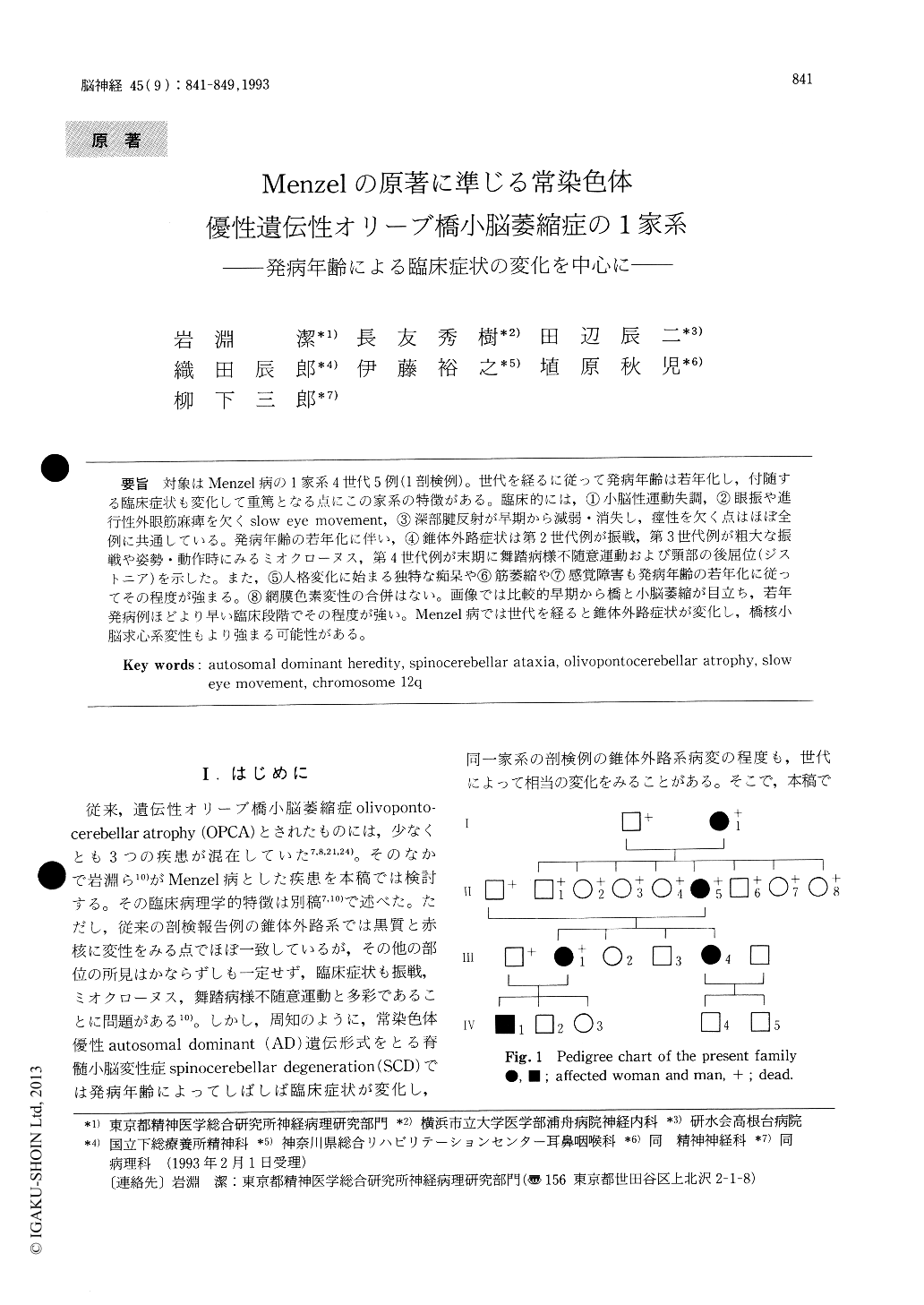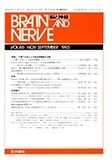Japanese
English
- 有料閲覧
- Abstract 文献概要
- 1ページ目 Look Inside
対象はMenzel病の1家系4世代5例(1剖検例)。世代を経るに従って発病年齢は若年化し,付随する臨床症状も変化して重篤となる点にこの家系の特徴がある。臨床的には,①小脳性運動失調,②眼振や進行性外眼筋麻痺を欠くslow eye movement,③深部腱反射が早期から減弱・消失し,痙性を欠く点はほぼ全例に共通している。発病年齢の若年化に伴い,④錐体外路症状は第2世代例が振戦,第3世代例が粗大な振戦や姿勢・動作時にみるミオクローヌス,第4世代例が末期に舞踏病様不随意運動および頸部の後屈位(ジストニア)を示した。また,⑤人格変化に始まる独特な痴呆や⑥筋萎縮や⑦感覚障害も発病年齢の若年化に従ってその程度が強まる。⑧網膜色素変性の合併はない。画像では比較的早期から橋と小脳萎縮が目立ち,若年発病例ほどより早い臨床段階でその程度が強い。Menzel病では世代を経ると錐体外路症状が変化し,橋核小脳求心系変性もより強まる可能性がある。
Recent progress in neurology has revealed that hereditary olivo-ponto-cerebellar atrophy (OPCA) is in fact three different diseases. These are Menzel's disease, in which degeneration in the olivopontocerebellar (OPC) system is quite severe and similar to that of the patient described by Menzel in 1891, spinocerebellar ataxia 1 (SCA 1), in which the gene locus exists in the short arm of chromosome 6, and hereditary OPCA with retinal degeneration. We present a family with Menzel's disease, some of whom showed dementia and vari-ous extrapyramidal symptoms including tremor, myoclonus, and choreoathetoid involuntary move-ment.
Meterials : This dominant hereditary cerebellar ataxia family had five affected members in four generations. Neuropathological examination of one member (Case 3) revealed Menzel's disease. There was severe degeneration in the OPC system, the substantia nigra, Clarke's column, the posterior column, and the anterior horn of the spinal cord, and slight-to-moderate degeneration in the globus pal-lidus and subthalamic nucleus. However, the dentate nucleus, spinocerebellar tracts, and oculo-motor nucleus including the medial longitudinal fasciculus were spared. The brain weight was 990 g.
Case 1 (Case 3's grandmother) developed slowly progressive ataxia at the age of 55. She showed no involuntary movement or dementia. She died at 63 years of age. Case 2 (Case 3's mother) developed ataxia at 42 years of age, followed by tremor of the hands and head, and died at age 57. She did not show dementia. Case 3 (the autopsied case) deve-loped progressive ataxia at 27 years of age, foll-owed by mental deterioration, tremor, myoclonus, and generalized amyotrophy and sensory distur-bance during her fifth decade. She died at age 48. Case 4 (a sister of Case 3), who is now 50 years old, developed ataxia at 30 years of age. Her clinical symptoms were similar to those of her sister. Case 5 (a son of Case 3) developed ataxia at 13 years of age, followed by mental deterioration, generalized muscular atrophy, sensory disturbance, brady-kinesia, and choreiform involuntary movement dur-ing his third decade. He is now bedridden and mentally indifferent at the age of 29. Neurological examination was performed in all four patients except Case 1. All showed cerebellar ataxia, de-creased or absent deep tendon reflexes, especially in the lower extremities, and viscous slow eye move-ment without nystagmus or progressive oculomotor palsy. Dementia developed in Case 3, 4, and 5. Extrapyramidal symptoms varied according to the age at onset. MRI conducted in Case 4 and 5 during the same clinical stage suggested that the degenera-tion in the ponto-cerebellar system of the younger patient was more severe than that in the older one.
In conclusion, the extrapyramidal symptoms and mental deterioration in Menzel's disease varied according to the age at onset, while cerebellar ataxia, decreased or absent deep tendon reflexes, and viscous slow eye movement without nystagmus were common findings in all generations of a single family.

Copyright © 1993, Igaku-Shoin Ltd. All rights reserved.


